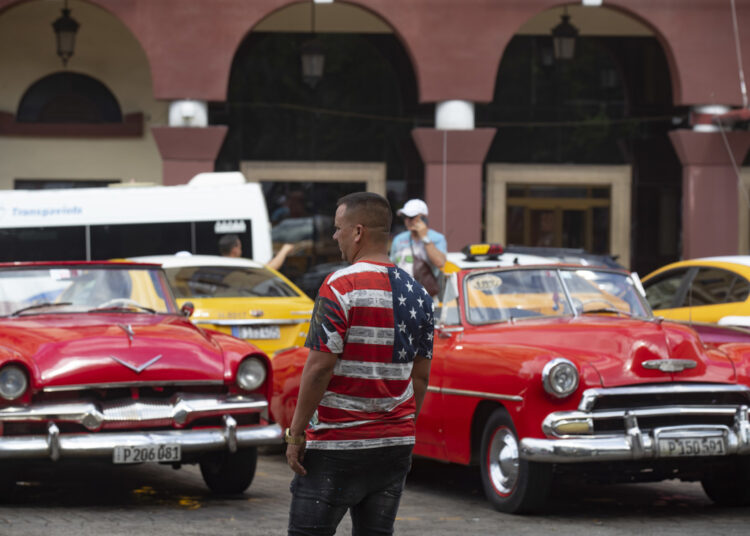Last weekend, while listening to artists and writers at their Congress, I thought again that our relationship with the United States is, first and foremost, a cultural problem. Although there was no time there to debate that relationship and draw practical lessons to improve it, a question came to mind: How aware and prepared are we to take on this encounter between the two societies that have been emerging over the last twenty years? Since understanding that relationship is not an optional subject, or one that we can put off for later because it supposedly “distracts us from solving our own problems” or because not being leaders or diplomats, it is a foreign matter.
Although the result of the U.S. elections may or may not push it in a certain direction, this relationship between countries does not depend, strictly speaking, on who won. Being a cultural phenomenon, it concerns currents of exchange that underlie Cuban society inside and outside; as well as our ability to understand the neighbor on the upper floors, with its imperialism that has plagued us for more than a century and a half, and with its culture and society that are part of the melting pot that we are (Fernando Ortiz dixit). That is why critical awareness is so important to look at it (and see it) head-on and in its complexity.
We have not been the only ones frightened by the fact that a politician from the new extreme right, whose rise extends to Europe and Latin America, is once again enthroned in the White House; within a presidential system, in which the executive concentrates colossus power.
In fact, many are more worried than we are with Trump’s second term, including some of his allies and adversaries. It could even be said that, among all Latin Americans and Caribbeans, we are the most prepared: none has accumulated so much experience of U.S. hostility as Cuba, to the point of becoming a habit. In fact, we have been much less accustomed to Barack Obama’s good manners and conversational tone than to Donald Trump’s brutal and threatening style.
Although a friend of mine had bet me that Kamala Harris would win by a landslide and kick Trump out, I preferred to opt, as a “working hypothesis,” that the extreme right would win again, and we would have it for another four years. In this scenario “of horror and mystery,” I will discard the commonly accepted belief that U.S. politicians soften towards Cuba in their second term. First, because this oft-repeated thesis lacks sufficient evidence; and second, because there is no reason to think that DT has any special interest in the island, not even the one dictated by business logic, as I imagined when he was elected in 2016. And since he is not interested, he can leave it to anyone, be it Marco Rubio or the Veterans Association of Brigade 2506. As they say, who cares?
I am interested in discussing what we can do to foster relationships and interests that counteract the effects of a new Trump presidency. And, given that politics is based more on interests than on other affinities, what can Americans want that we Cubans can offer them, and with what comparative advantages?
Contrary to what is often assumed, we are not at zero. Cuba and the United States have common interests identified in areas of cooperation such as migration, drug trafficking, environmental protection, law enforcement, fighting crime, etc. In these issues, the main interlocutor has been Homeland Security (DHS) more than the State Department; and in no case Congress.
For the agencies that operate under the umbrella of the DHS, from the Coast Guard to the FBI, including the DEA, cooperation with Cuba and dialogue with its institutions is of greater interest, not only as a bilateral agenda but in its coverage of the Caribbean, with which the island maintains close relations.
If we think about Cuba’s post-Cold War cooperation with the Caribbean, we will find areas that can serve as a guide to thinking about alternative relations with the United States. Beyond trade and tourism, there are public health, education, civil defense against hurricanes, national and public security, the development of cultural industries, and environmental protection.
In this column I have referred previously to subnational relations; that is, between actors in Cuba and in various states of the Union; as well as with different U.S. decentralized public agencies.
Public health institutions dedicated to fighting epidemics have maintained communication and cooperation, long before the COVID-19 pandemic, in relation to diseases in humans and animals, here, and in other countries, such as Haiti and West Africa, regarding hemorrhagic dengue and Ebola. This cooperation covers periods with Republican administrations.
In matters of the environment, civil defense, and health, Cuba has cooperated, for example, with the government of Louisiana, starting with the recovery after Hurricane Katrina (2005). And it has maintained relations for years with agencies dedicated to the protection of the environment, especially the shared marine areas on the borders between both countries and the fauna of birds and fish that constantly migrate between the territories.
Exchange programs have been developed between U.S. universities and foundations, and Cuban higher education centers, cultural, scientific, and health institutions, such as the Pedro Kourí Institute of Tropical Medicine (IPK), the Higher Institute of Art, the Center for Sex Education (CENESEX), Casa de las Américas, and the main Cuban universities. Academic organizations such as LASA have welcomed numerous members residing on the island. And U.S. students have graduated from ELAM in medicine and other careers.
Most of these relations have taken place, however, at the initiative of the U.S. side. The Cuban institutions involved have maintained a reactive policy, limited to accepting proposals. They have not dedicated themselves to outlining a strategy for closer collaboration, nor to exploring new interlocutors on the other side.
A main dimension of subnational relations has been the use of commercial opportunities opened in the few cracks of the blockade, particularly at the level of the States. Also under Republican administrations.
As is known, from the beginning the Cuban government has had a leading role in these purchases, especially of food. These are anomalous transactions in terms of international trade, since they lack bank credits and other guarantees, and are made through cash payments and banks in third countries. Although I do not have precise data, since Cuban private enterprises (MSMEs) expanded in the island’s domestic trade, they have acquired an ostensible and growing weight in these operations.
I begin by pointing out that, according to the figures available on U.S.-Cuba trade, in the Trump years (2017-2021), these sales remained even above the Obama period; and they fell relatively during the Biden administration, especially in the years of the pandemic, recovering later.
When reporting on export data to Cuba in 2022, the Observatory of Economic Complexity says that the majority of its total value (341 million) was food, consisting of chicken (86% of the total value), soybeans, and corn, followed by “vehicles,” as well as some dairy products, eggs, coffee, and other products. This composition was maintained until the summer of 2024. The states from which they originated were Florida (more than half of the total value), followed by Georgia, Mississippi, Texas, and Louisiana.
Interestingly, the 5.6 million that the United States imported from Cuba in 2022 consisted of cultural products: “paintings” (4.7 million), as well as “antiques” and “sculptures.” Although they decreased in 2023-2024, the composition of these imports remained the same, destined for NY (almost all) and Florida.
I will leave for another time the analysis of the relations with corporate interests and congresspeople from some of these states, where the Republicans’ red color prevails. Just remember that both they and the Democrats have the mission of promoting the economic interests of their country, especially promoting exports. The existence of a potential market as close as Cuba is not insignificant to them.
Finally, I return to our domestic policy and the cultural issue.
Knowing that for years paintings and sculptures have been classified as “information products” exempt from the blockade and that buyers of Cuban art can legally import them into the United States, I asked a friend in the field about the subject. He is also surprised by the fact that works of plastic art are a prominent import item in such an asymmetric trade balance. And he tells me about the anomaly of the art market in Cuba.
Buyers do not go to Cuban galleries or institutions that promote the domestic art market, because the profile of these institutions is very low, and because the structuring of the art market is inefficient. Without a structured domestic market, as exists everywhere, he says, informality prevails: buyers go directly to the artists’ ateliers, negotiate prices, and comply with the registration to legally extract them.
Some regulations limit the amount of works that can be sold (let’s say, that “cap” that amount), but controlling it is haphazard, while artists can send their works abroad to participate in exhibitions. In fact, they become their own exporters. My friend speculates that these are the ways how galleries in New York and Florida receive and market that art. All legally.
In a nutshell, this small, great example of the art market serves to illustrate the central point of this article: how to open and use the parallel channels that have been enabled between the two sides, outside of intergovernmental relations. And how the structuring of a domestic market with clear, realistic, and viable rules is a precondition to achieve this.
The example at hand is the role of MSMEs in expanding a commercial relationship whose figures I already gave above. Given the space that these actors have in the regulations of the U.S. government, taking advantage of it seems the most reasonable and useful for the national interest. It is not new that when they (the government and its political cronies) loosen the screws of the blockade for businesspeople or artists, they are betting that they are the gravediggers of the system and that they are eroding it from within. But reacting to that intention by imposing restrictions is a way of following the line of that policy. We could rather learn from the judo masters: to deal with a bigger opponent, we must make intelligent use of the opponent’s impulse to attack in our favor. In other words: a consistent and stable policy toward private actors is a key antidote to the scenario of our relations in the foreseeable future.
The last of those antidotes is relations with emigrants. On this subject, I have nothing to add to what has been argued in this column, and research works. These relations are also domestic policy because it deals with the space of emigrants as Cuban citizens.
I will limit myself to sharing a proposal put forward at the Congress of writers and artists: “Institutionalize relations with Cuban culture abroad, through permanent mechanisms, that allow for the development of channels and means that facilitate relations with those who identify themselves as Cubans in other countries, and in particular, expand and deepen the exchange and active participation of emigrated writers and artists, to promote common initiatives.”
It is, of course, a two-way road, which allows not only dealing with the blockade but also assuming the structural character of this emigration with respect to present and future Cuban society.
A farmer friend of mine who grows coffee in the hills asked me the last time who was going to win in the U.S. elections. I told him that I didn’t know, naturally; but that we would do well to prepare ourselves for the worst of all to win. When he reads this article, he will surely tell me that it is too big a bite to chew in one go.
I will tell him that we should continue to mull it over in other conversations, when this hurricane, whose name in ancient Hebrew evokes the power of healing, passes. And it will not be the last one either.










